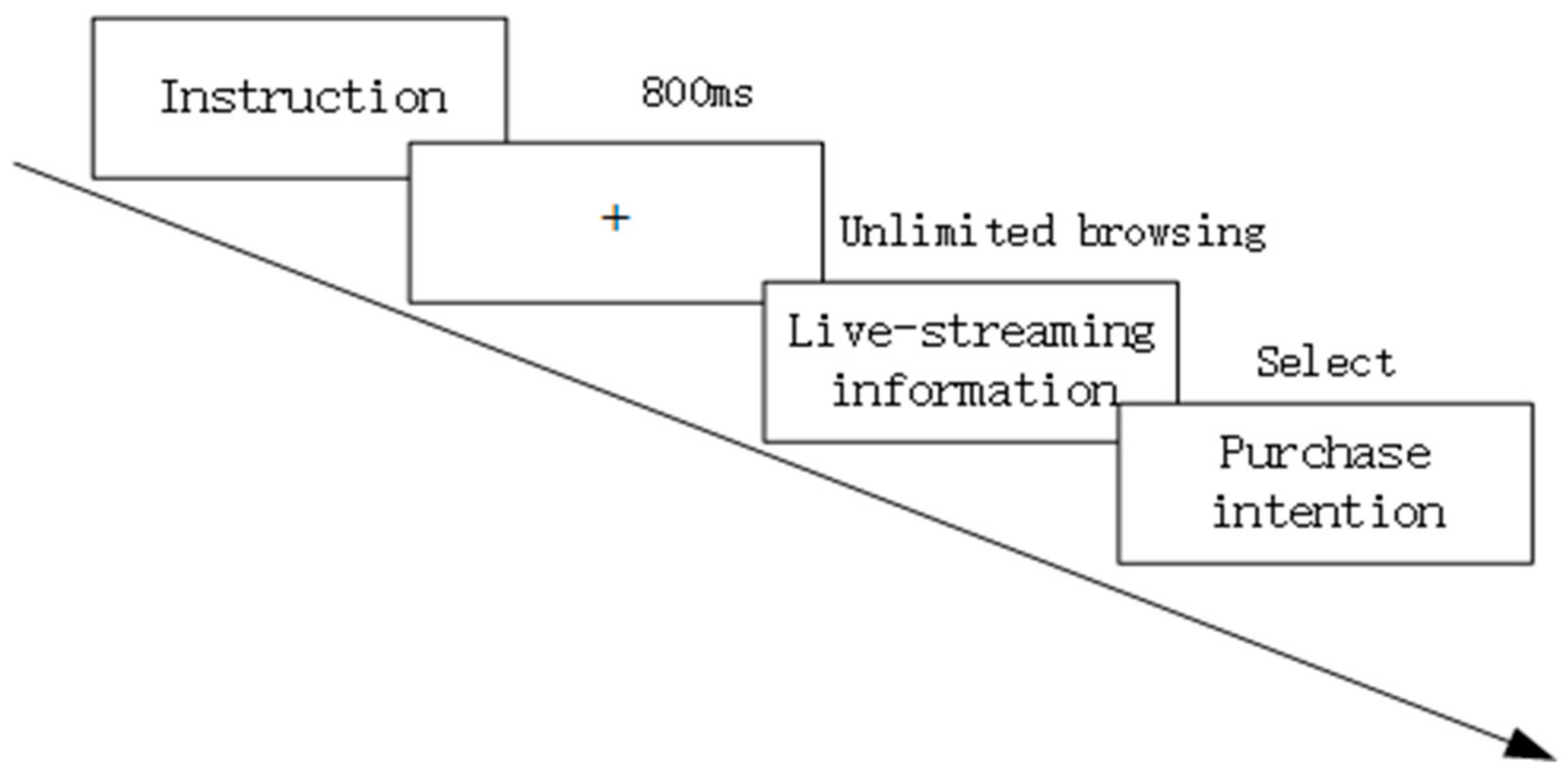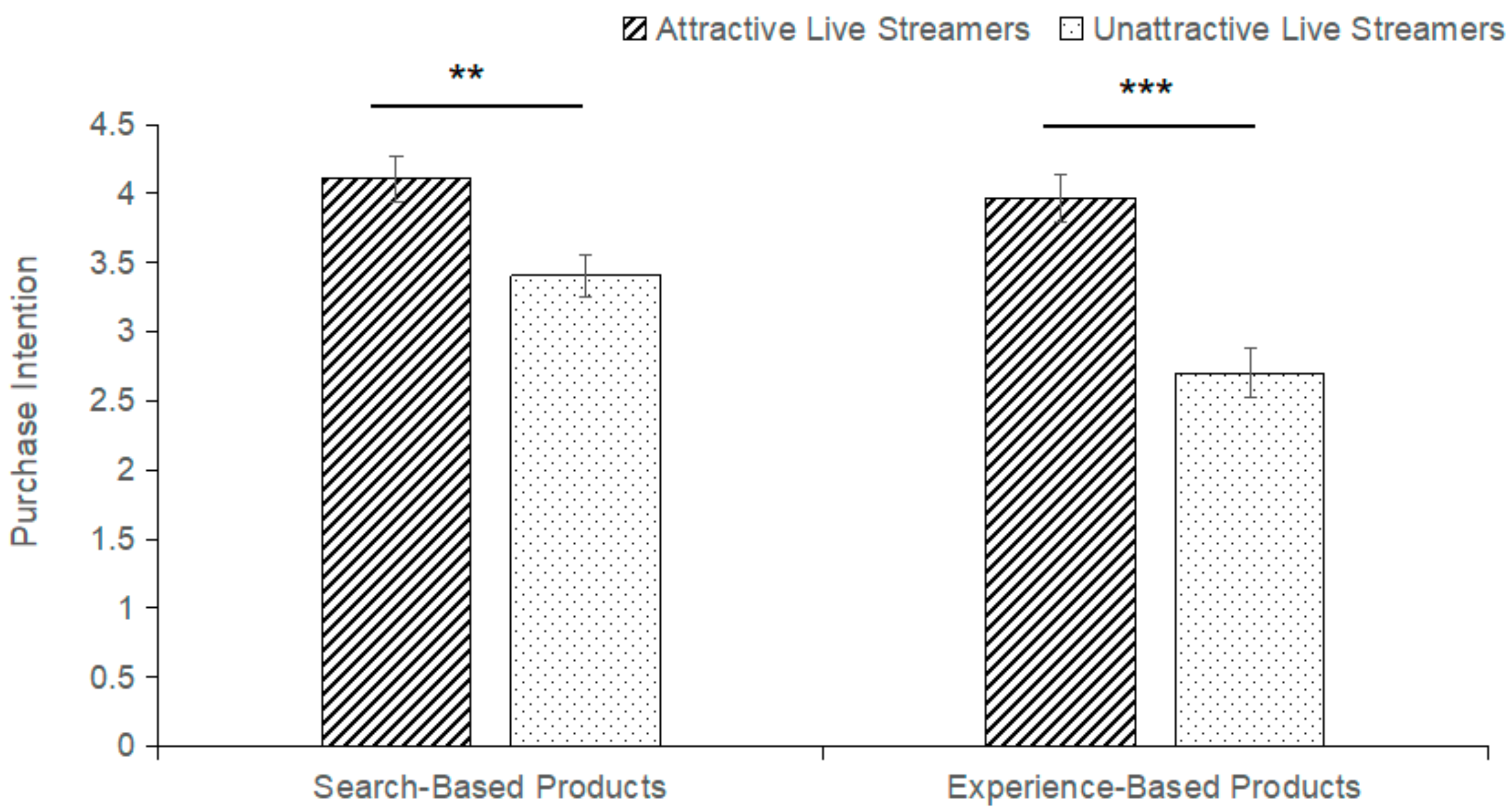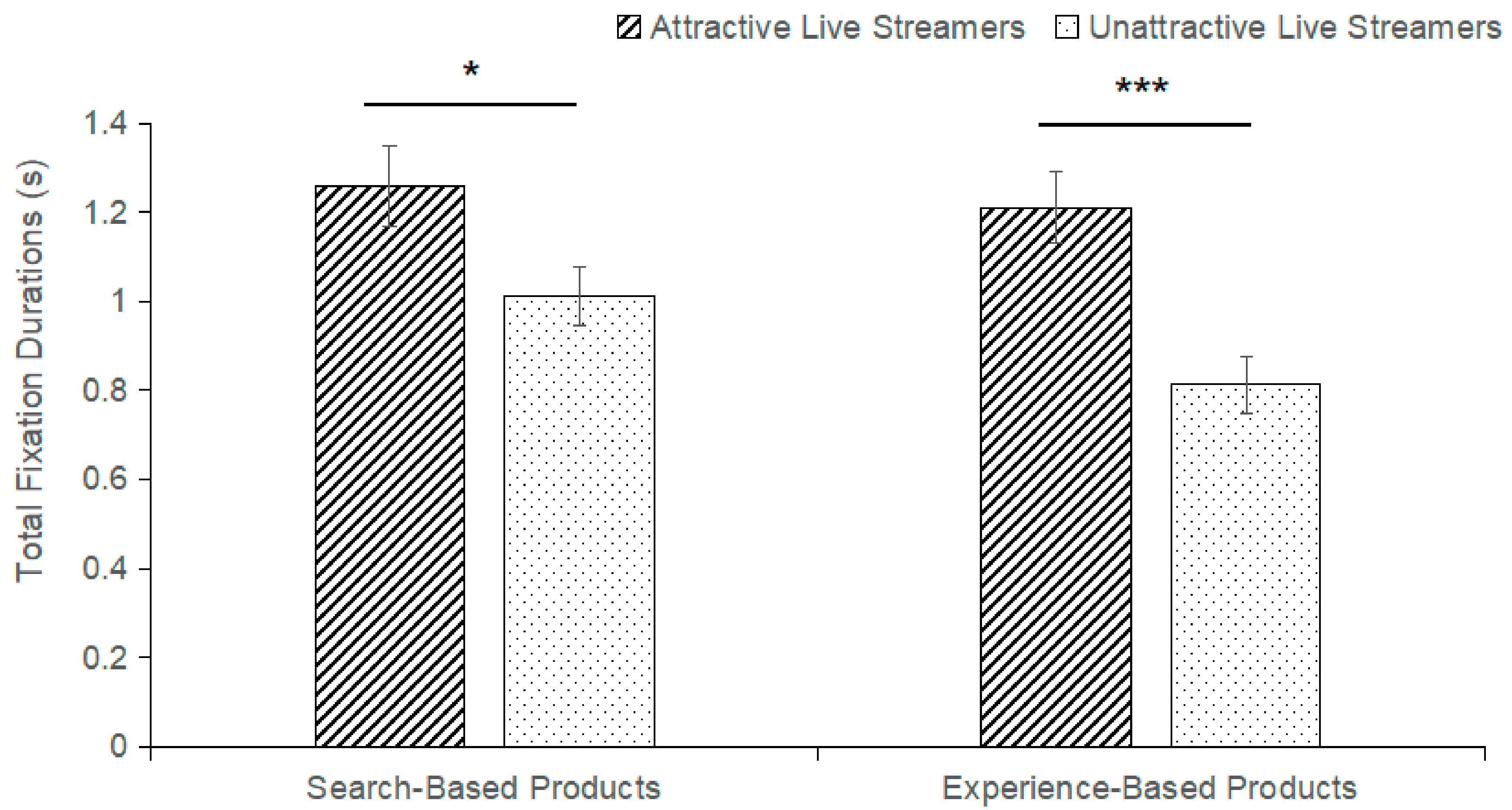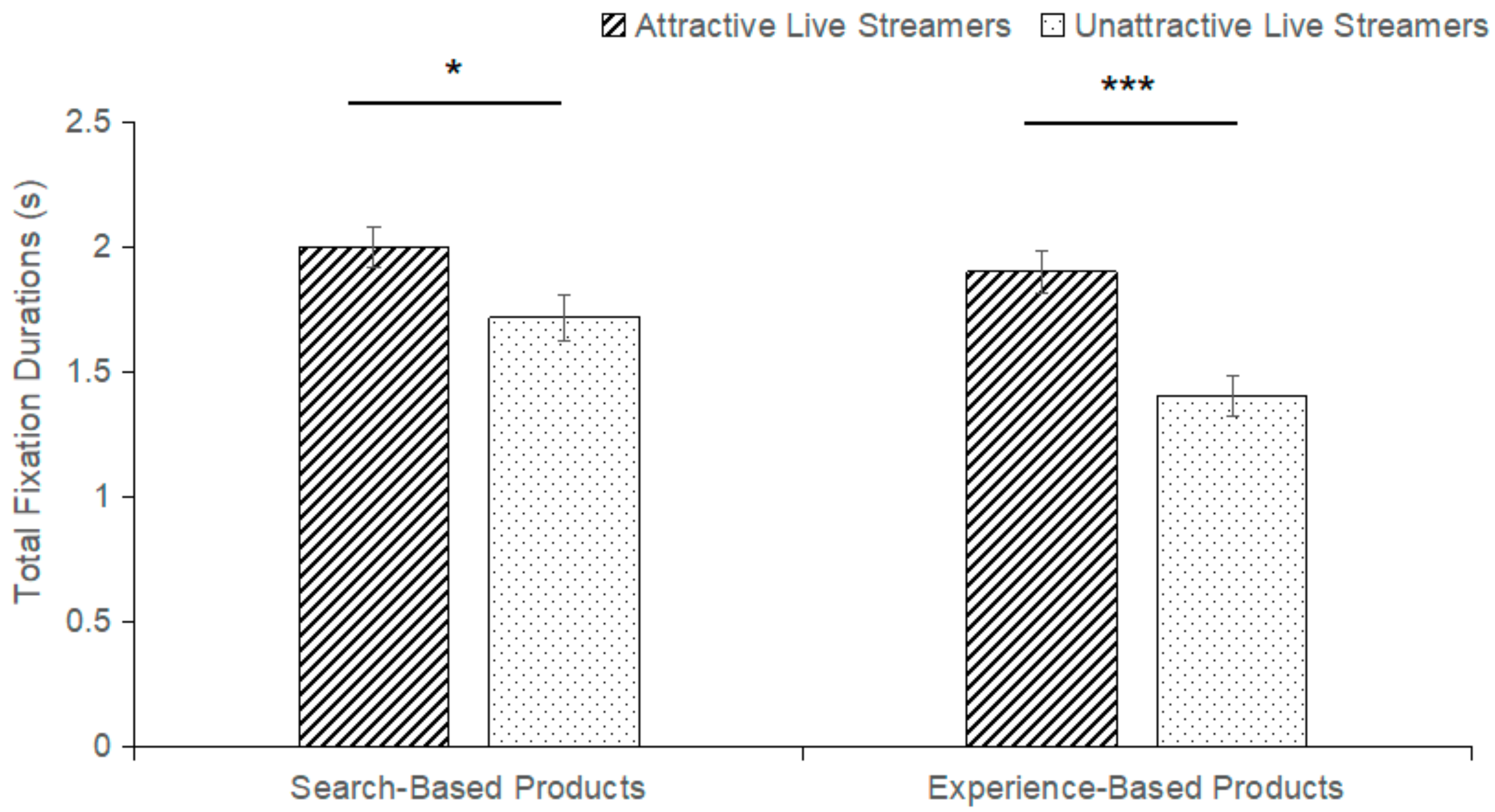The Effects of Live Streamer’s Facial Attractiveness and Product Type on Consumer Purchase Intention: An Exploratory Study with Eye Tracking Technology
Abstract
:1. Introduction
2. Theoretical Foundations and Hypothesis Development
2.1. SOR Theory
2.2. Facial Attractiveness and Purchase Intention
2.3. The Mediating Role of Emotional Experience
2.4. The Effect of Product Types
2.5. Eye Tracking Technology
3. Research Methods and Design
3.1. Study 1: Questionnaire Survey
3.1.1. Survey Instrument
3.1.2. Sample and Data Collection
3.1.3. Analysis and Discussion of Data Results
Reliability and Validity
Path Analysis and Hypothesis Testing
3.2. Study 2: Eye-Tracking Experiment
3.2.1. Participants
3.2.2. Stimuli
3.2.3. Experimental Design
3.2.4. Results
Results of Behavior Data
Results of Eye Movement Data
4. Discussions
4.1. The Relationship between Facial Attractiveness, Emotional Experience, and Purchase Intention
4.2. The Effect of Facial Attractiveness and Product Type on Purchase Intention
4.3. The Effect of Facial Attractiveness and Product Type on Consumer Visual Attention
5. Conclusions and Suggestions
5.1. Conclusions
5.2. Suggestions and Research Limitations
Author Contributions
Funding
Institutional Review Board Statement
Informed Consent Statement
Data Availability Statement
Conflicts of Interest
References
- 52nd Statistical Report on the Development of Chinese Internet. 28 August 2023. Available online: https://www3.cnnic.cn/n4/2023/0828/c88-10829.html (accessed on 14 March 2024).
- Research Report on China’s Live E-Commerce Industry in 2023. 1 March 2024. Available online: https://www.iresearch.com.cn/Detail/report?id=4316&isfree=0 (accessed on 14 March 2024).
- Kim, J.; He, N.; Miles, L. Live Commerce Platforms: A New Paradigm for E-Commerce Platform Economy. J. Theor. Appl. Electron. Commer. Res. 2023, 18, 959–975. [Google Scholar] [CrossRef]
- Cheng, C.; Hu, Y.; Lu, Y.; Hong, Y. Everyone can be a star in the digital economy: Quantifying the business value of live streaming technology in online retail. SSRN Electron. J. 2019. [Google Scholar] [CrossRef]
- Chen, X.; Shen, J.; Wei, S. What reduces product uncertainty in live streaming e-commerce? From a signal consistency perspective. J. Retail. Consum. Serv. 2023, 74, 103441. [Google Scholar] [CrossRef]
- Nakamura, K.; Kawabata, H. Attractive faces temporally modulate visual attention. Front. Psychol. 2014, 5, 620. [Google Scholar] [CrossRef]
- Erdogan, Z.B. Celebrity Endorsement: A Literature Review. J. Mark. Manag. 1999, 15, 291–314. [Google Scholar] [CrossRef]
- Jimenez, F.R.; Mendoza, N.A. Too Popular to lgnore: The Influence of Online Reviews on Purchase Intentions of Search and Experience Products. J. Interact. Mark. 2013, 27, 226–235. [Google Scholar] [CrossRef]
- Woodworth, R.S. Dynamic Psychology. Columbia University Lectures; Kessinger Publishing: Whitefish, MT, USA, 1926; pp. 103–118. [Google Scholar]
- Mehrabian, A.; Russell, J.A. An Approach to Environmental Psychology; MIT Press: Cambridge, UK, 1974; pp. 24–30. [Google Scholar]
- Donovan, R.J.; Rossiter, J.R. Store Atmosphere: An Environmental Psychology Approach. J. Retail. 1982, 58, 34–57. [Google Scholar]
- Jakubowska, D.; Sadilek, T. Sustainably produced butter: The effect of product knowledge, interest in sustainability, and consumer characteristics on purchase frequency. Agric. Econ. 2023, 69, 25–34. [Google Scholar] [CrossRef]
- Wilson, K. Beauty and the Labour Market: An Article Critique On Hemermesh and Biddle’s. Bus. Intell. J. 2008, 1, 148. [Google Scholar]
- Poutvaara, P. Facial appearance and leadership: An overview and challenges for new research. Leadersh. Q. 2014, 25, 801–804. [Google Scholar] [CrossRef]
- Mengelkoch, S.; Gassen, J.; Prokosch, M.L.; Boehm, G.W.; Hill, S.E. More than just a pretty face? The relationship between immune function and perceived facial attractiveness. Proc. R. Soc. B Biol. Sci. 2022, 289, 20212476. [Google Scholar] [CrossRef] [PubMed]
- Martin, W.; Patrick, M.; Johannes, H. The value of a real face: Differences between affective faces and emojis in neural processing and their social influence on decision-making. Soc. Neurosci. 2020, 15, 255–268. [Google Scholar]
- Ahmed, S.; Ranta, M.; Vähämaa, E.; Vähämaa, S. Facial attractiveness and CEO compensation: Evidence from the banking industry. J. Econ. Bus. 2023, 123, 106095. [Google Scholar] [CrossRef]
- Khalid, R.; Yasmeen, T. Celebrity physical attractiveness effect on consumer buying behavior. JEMA J. Llmiah Bid. Akunt. Dan Manaj. 2019, 16, 173–180. [Google Scholar] [CrossRef]
- Sajjacholapunt, P.; Ball, L.J. The influence of banner advertisements on attention and memory: Human faces with averted gaze can enhance advertising effectiveness. Front. Psychol. 2014, 5, 70413. [Google Scholar] [CrossRef]
- Argo, J.J.; Dahl, W.D.; Morales, C.A. Positive Consumer Contagion: Responses to Attractive Others in a Retail Context. J. Mark. Res. 2008, 45, 690–701. [Google Scholar] [CrossRef]
- Deska, J.C.; Hingston, S.T.; DelVecchio, D.; Kurt, H. The face of the brand: Spokesperson facial width-to-height ratio predicts brand personality judgments. Psychol. Mark. 2022, 39, 1487–1503. [Google Scholar] [CrossRef]
- Pornpitakpan, C.; Yuan, Y.; Han, J.H. The effect of salespersons’ retail service quality and consumers’ mood on impulse buying. Australas. Mark. J. 2017, 25, 2–11. [Google Scholar] [CrossRef]
- Moors, A.; Ellsworth, C.P.; Scherer, R.K.; Frijda, N.H. Appraisal Theories of Emotion: State of the Art and Future Development. Emot. Rev. 2013, 5, 119–124. [Google Scholar] [CrossRef]
- Williamson, K.A.; Thulin, E. Leveraging emotion-behavior pathways to support environmental behavior change. Ecol. Soc. 2022, 27, 27. [Google Scholar] [CrossRef]
- Watson, L.; Spence, T.M. Causes and consequences of emotions on consumer behaviour: A review and integrative cognitive appraisal theory. Eur. J. Mark. 2007, 41, 487–511. [Google Scholar] [CrossRef]
- Leder, H.; Mitrovic, A.; Goller, J. How Beauty Determines Gaze! Facial Attractiveness and Gaze Duration in Images of Real World Scenes. I-Perception 2016, 7, 537–551. [Google Scholar] [CrossRef] [PubMed]
- Jung, H.; Bake, E.; Choo, H.J. Effects of human crowding and the physical attractiveness of others on customers in stores. J. Glob. Fash. Mark. 2017, 8, 69–82. [Google Scholar] [CrossRef]
- Li, M.; Wang, Q.; Cao, Y. Understanding Consumer Online Impulse Buying in Live-Streaming E-Commerce: A Stimulus-Organism-Response Framework. Int. J. Environ. Res. Public Health 2022, 19, 4378. [Google Scholar] [CrossRef] [PubMed]
- Vrtana, D.; Krizanova, A. The Power of Emotional Advertising Appeals: Examining Their Influence on Consumer Purchasing Behavior and Brand–Customer Relationship. Sustainability 2023, 15, 13337. [Google Scholar] [CrossRef]
- Hahn, A.C.; Perrett, D.I. Neural and behavioral responses to attractiveness in adult and infant faces. Neurosci. Biobehav. Rev. 2014, 46, 591–603. [Google Scholar] [CrossRef] [PubMed]
- Kamins, A.M. An Investigation into the “Match-up” Hypothesis in Celebrity Advertising: When Beauty May Be Only Skin Deep. J. Advert. 1990, 19, 4–13. [Google Scholar] [CrossRef]
- Wen, T.; Peng, Q. Review of Facial Attractiveness from Marketing Perspective. J. Dalian Univ. 2022, 43, 82–89. [Google Scholar]
- Nelson, P. Information and consumer behavior. J. Political Econ. 1970, 78, 311–329. [Google Scholar] [CrossRef]
- Wang, Z.X. Characteristics on Consumers’ Purchasing Intentions in Live Streaming. Shanghai Manag. Sci. 2023, 45, 9–14. [Google Scholar]
- Wang, H.J.; Ding, J.Y.; Akram, U.; Yue, X.L.; Chen, Y.T. An empirical study on the impact of e-commerce live features on consumers’ purchase intention: From the perspective of flow experience and social presence. Information 2021, 12, 324. [Google Scholar] [CrossRef]
- Chen, R.X.; Li, Y.Y. A study of factors influencing the usefulness of online reviews—The moderating effects of brand reputation and product type. Oper. Res. Manag. 2023, 32, 193–199. [Google Scholar]
- Markopoulos, P.M.; Clemons, E.K. Reducing Buyers’ Uncertainty about Taste-Related Product Attributes. J. Manag. Inf. Syst. 2013, 30, 269–299. [Google Scholar] [CrossRef]
- Zhang, M.; Qin, F.; Wang, G.A.; Luo, C. The impact of live video streaming on online purchase intention. Serv. Ind. J. 2020, 40, 656–681. [Google Scholar] [CrossRef]
- Just, M.A.; Carpenter, P.A. Eye fixations and cognitive processes. Cogn. Psychol. 1976, 8, 441–480. [Google Scholar] [CrossRef]
- Greenwald, A.G.; Leavitt, C. Audience involvement in advertising: Four levels. J. Consum. Res. 1984, 11, 581–592. [Google Scholar] [CrossRef]
- Lacoste-Badie, S.; Yu, J.; Droulers, O. Small change, big change—Increasing attention with product package variations. Food Qual. Prefer. 2020, 86, 104007. [Google Scholar] [CrossRef]
- Ehmke, C.; Wilson, S. Identifying Web Usability Problems from Eye-tracking Data. In Proceedings of the 21st British HCI Group Annual Conference on People and Computers 2007, Lancaster, UK, 3–7 September 2007; British Computer Society: Swinton, UK; pp. 119–128. [Google Scholar]
- Liu, C.H.; Chen, W. Beauty is better pursued: Effects of attractiveness in multiple-face tracking. Q. J. Exp. Psychol. 2012, 65, 553–564. [Google Scholar] [CrossRef] [PubMed]
- Bei, L.; Chen, Y.E.; Widdows, R. Consumers online information search behavior and the phenomenon of search vs. experience products. Early Child. Educ. J. 2004, 25, 449–467. [Google Scholar] [CrossRef]
- McCroskey, L.L.; McCroskey, J.C.; Richmond, V.P. Analysis and improvement of the measurement of interpersonal attraction and homophily. Commun. Q. 2006, 54, 1–31. [Google Scholar] [CrossRef]
- Ohanian, R. The impact of celebrity spokesperson’s perceived image on consumers’ intention to purchase. J. Advert. Res. 1991, 31, 46–52. [Google Scholar]
- Kim, H.; Lennon, S.J. E-atmosphere, emotional, cognitive, and behavioral responses. J. Fash. Mark. Manag. 2010, 14, 412–428. [Google Scholar] [CrossRef]
- Li, J.Y.; Li, L.Z. The impact of the characteristics of live-streamering e-commerce live streamer on consumers’ willingness to repurchase—Take Tiktok as an example. Merch. Bus. Econ. Res. 2022, 10, 71–75. [Google Scholar] [CrossRef]
- Hayes, A. Introduction to Mediation, Moderation, and Conditional Process Analysis. J. Educ. Meas. 2013, 51, 335–337. [Google Scholar]
- Li, Z.W. Analysis of the Differences in Online Comments between Experiential and Search Based Products. Mod. Manag. Sci. 2013, 8, 42–45. [Google Scholar] [CrossRef]
- Zhang, Y.H. Research on the influencing factors of the usefulness of online comments: Moderating effects based on product types. Manag. Rev. 2016, 28, 123–132. [Google Scholar]
- Póvoa, A.C.S.; Pech, W.; Viacava, J.J.C.; Schwartz, M.T. Is the beauty premium accessible to all? An experimental analysis. J. Econ. Psychol. 2020, 78, 102252. [Google Scholar] [CrossRef]
- Ishai, A. Sex, beauty and the orbitofrontal cortex. Int. J. Psychophysiol. 2007, 63, 181–185. [Google Scholar] [CrossRef] [PubMed]
- Michael, H.G. Attention Shoppers: The Currency of the New Economy Will Not Be Money, but Attention—A Radical Theory of Value 1997. Available online: http://www.wired.com/wired/archive/5.12/es_attention.html (accessed on 14 March 2024).
- Wang, Y.X.; An, Z.Z. Attention Economy: Production and Control of Consumer Attention in E-commerce Live Streaming. China Youth Res. 2021, 2, 14–21. [Google Scholar] [CrossRef]
- Fan, X.P.; Lu, Y.F.; Han, H.Y. The impact of online shopping information environment on consumer decision-making process: Based on the limited rationality perspective. J. Manag. Eng. 2016, 30, 38–47. [Google Scholar]
- Schmid, B.; Axhausen, K.W. In-store or Online Shopping of Search and Experience Goods: A Hbrid Choice Approach. J. Choice Model. 2019, 31, 156–180. [Google Scholar] [CrossRef]
- De, N.R.; Rhodes, A. Behavior-based Pricing with Experience Goods. Econ. Lett. 2012, 118, 155. [Google Scholar]
- Xu, H.W.; Niu, D.; Li, Q. Facial attractiveness and mate value: An evolutionary psychology perspective. Adv. Psychol. Sci. 2016, 24, 1130–1138. [Google Scholar] [CrossRef]
- Masuda, H.; Han, S.H.; Lee, J. Impacts of influencer attributes on purchase intentions in social media influencer marketing: Mediating roles of characterizations. Technol. Forecast. Soc. Change 2022, 174, 121246. [Google Scholar] [CrossRef]
- Ahn, J. The impact of support on behavioural intention in a customer-to-customer retail service context. Technol. Anal. Strateg. Manag. 2024, 1–11. [Google Scholar] [CrossRef]





| Latent Variable | Measurement Question | |
|---|---|---|
| Facial attractiveness | I would pay more attention to live streamers with attractive faces in the live streaming room. | |
| The beautiful face of the live streamers are highly appealing to me when I purchase items in the live streaming room. | ||
| The attractive face of live streamers in an e-commerce live stream room draws my attention to what he is publishing. | ||
| Emotional experience | Below are four descriptive emotional state words. Please rate each emotional word based on your actual emotional experience during the time you watched the live streaming and purchased the product in the live streaming room. | Happy |
| Relaxed | ||
| Excitedly | ||
| Lively | ||
| Purchase intention | I am willing to purchase items while watching the live stream. | |
| I would like to follow or buy related products recommended by the live streamers. | ||
| I would suggest people around me to shop with me inside the streaming room. | ||
| Question Items | Standard Load | Cronbach’ α | CR | AVE | |
|---|---|---|---|---|---|
| Facial attractiveness | q1 | 0.75 | 0.827 | 0.8265 | 0.6138 |
| q2 | 0.82 | ||||
| q3 | 0.78 | ||||
| Emotional experience | q4 | 0.8 | 0.821 | 0.8279 | 0.5474 |
| q5 | 0.65 | ||||
| q6 | 0.74 | ||||
| q7 | 0.76 | ||||
| Purchase intention | q8 | 0.76 | 0.824 | 0.8247 | 0.6107 |
| q9 | 0.78 | ||||
| q10 | 0.8 |
| Variable | M | SD | 1 | 2 | 3 |
|---|---|---|---|---|---|
| 1. Facial attractiveness | 5.60 | 0.85 | — | ||
| 2. Emotional experience | 5.56 | 0.73 | 0.57 ** | — | |
| 3. Purchase intention | 5.56 | 0.87 | 0.34 ** | 0.55 ** | — |
| Intermediary Path | Effect Value | Effect Proportion | Bootstrap 95% CI | ||
|---|---|---|---|---|---|
| LLCI | ULCI | ||||
| Total effect | 0.5513 | 0.4490 | 0.6540 | ||
| Direct effect | Facial attractiveness → Purchase intention | 0.3297 | 59.81% | 0.2118 | 0.3850 |
| Intermediary effect | Facial attractiveness → Emotional experience → Purchase intention | 0.2216 | 40.19% | 0.0314 | 0.1319 |
Disclaimer/Publisher’s Note: The statements, opinions and data contained in all publications are solely those of the individual author(s) and contributor(s) and not of MDPI and/or the editor(s). MDPI and/or the editor(s) disclaim responsibility for any injury to people or property resulting from any ideas, methods, instructions or products referred to in the content. |
© 2024 by the authors. Licensee MDPI, Basel, Switzerland. This article is an open access article distributed under the terms and conditions of the Creative Commons Attribution (CC BY) license (https://creativecommons.org/licenses/by/4.0/).
Share and Cite
Shi, R.; Wang, M.; Qiao, T.; Shang, J. The Effects of Live Streamer’s Facial Attractiveness and Product Type on Consumer Purchase Intention: An Exploratory Study with Eye Tracking Technology. Behav. Sci. 2024, 14, 375. https://doi.org/10.3390/bs14050375
Shi R, Wang M, Qiao T, Shang J. The Effects of Live Streamer’s Facial Attractiveness and Product Type on Consumer Purchase Intention: An Exploratory Study with Eye Tracking Technology. Behavioral Sciences. 2024; 14(5):375. https://doi.org/10.3390/bs14050375
Chicago/Turabian StyleShi, Rui, Minghao Wang, Tongjia Qiao, and Junchen Shang. 2024. "The Effects of Live Streamer’s Facial Attractiveness and Product Type on Consumer Purchase Intention: An Exploratory Study with Eye Tracking Technology" Behavioral Sciences 14, no. 5: 375. https://doi.org/10.3390/bs14050375
APA StyleShi, R., Wang, M., Qiao, T., & Shang, J. (2024). The Effects of Live Streamer’s Facial Attractiveness and Product Type on Consumer Purchase Intention: An Exploratory Study with Eye Tracking Technology. Behavioral Sciences, 14(5), 375. https://doi.org/10.3390/bs14050375








